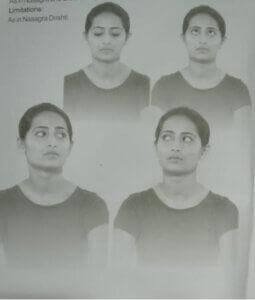1.Nasagra Drishti (Nasal Gaze)
Sit in Sukhasana or Vajrasana. Keep the head, neck and spine erect. Fix the eyes on the tip of the nose. Continue to gaze for a few seconds. Keep the gaze without flickering eyelids. Slowly close eyes. Cup them softly. Repeat after a few seconds. Practice it for a few seconds and then increase this Nasagra Drishti to a minute.
Benefits: Helps in concentration.Cools and strengthens the mind.
Limitations: Any severe eye injury like retinal detachment.

2.Bhrumadhya Drishti (Eyebrow Gaze)
Sit in either Sukhasana or Vajrasana.Keep the head, neck and spine straight. Focus the eyes on the space between the eyebrows. Keep this gaze for a few seconds. Slowly close eyes. Cup them softly. Repeat after a few seconds.
Benefits: As in Nasagra Drishti. Also tones up eye muscles hence good for the health of eyes.
Limitations: As in Nasagra Drishti.

3.Jatru Drishti (Equal Gaze)
Sit erect in any comfortable position, Now slowly look to the extreme right side, maintain for some time; then, extreme upward, maintain; then extreme left, and maintain; then down and again maintain for some time; and finally, look straight and close your eyes for a few seconds. Repeat the same thing in the anti-clockwise direction.
Benefits: As in Nasagra and Bhrumadhya Drishti.
Limitations: As in Nasagra Drishti.

4.Trataka (Candle Gazing)
Gaze on the flame of a candle without blinking eyes as long as possible. After a comfortable gaze, close eyes. With cupped hands shield the closed eyes for a couple of seconds. Trataka can be practiced by gazing at the tip of the thumb.
Benefits: Obviously very good for your eyes. It improves awareness, attention span, concentration, memory, emotional intelligence and gives peace of mind. Besides giving balanced attitude and health, it is an excellent cleansing process for the mind.
Limitations: Severe eye injury.











